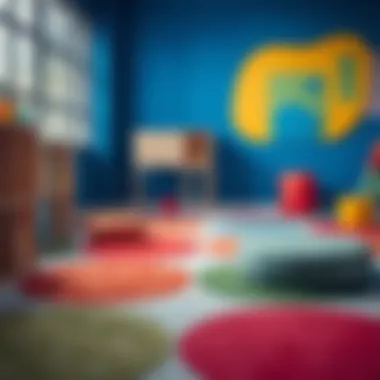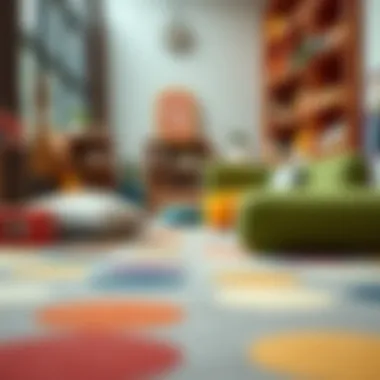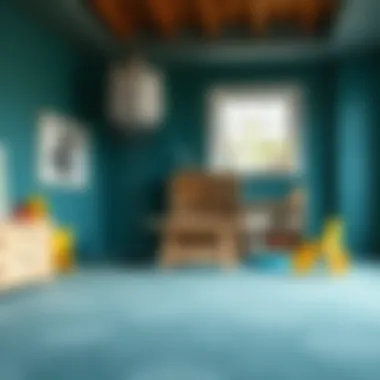Choosing the Right Play Area Carpets for Kids


Intro
When it comes to creating the perfect space for children to play, the choice of flooring can make all the difference. Play area carpets are not just decorative pieces—they play a vital role in child development, ensuring safety, comfort, and stimulating creativity. In this guide, we will delve deep into play area carpets, exploring everything from the materials used to current design trends, and how they impact both aesthetics and functionality in your home. Let's uncover the layers behind selecting the right carpet for playful environments, considering insights from design experts, parents, and child development specialists along the way.
Design Trends
Current Trends in Carpet Design
As homeowners look for ways to enhance their spaces while making them child-friendly, various design trends have emerged in the realm of play area carpets. These trends prioritize not only aesthetic appeal but also the sensory experiences of children.
Natural Materials
More parents are leaning towards carpets made from organic fibers like wool or cotton. These materials not only ensure a softer touch but are also less likely to trigger allergens, which is especially important in a child's play environment.
Bold Patterns and Colors
Gone are the days of solid, muted carpets. Vibrant patterns that encourage imagination—like jungle prints, cityscapes, or whimsical designs—are gaining traction. This aligns well with children's natural inclination towards playful, engaging visuals. A well-chosen carpet can inspire storytelling or imaginative play.
Eco-friendly Options
Sustainability has become a strong focus in many households. Carpets that are made from recycled materials or are free from harmful chemicals cater to environmentally conscious buyers. Not only do these options promote better health, but they also support a larger movement towards eco-friendly living.
How to Incorporate Trends into Your Space
When selecting a carpet, consider how these trends can integrate into your current home layout. Here are a few pointers:
- Choose Complementary Colors: Opt for patterns or colors in the carpet that reflect or enhance the existing palette of the room.
- Mix and Match: Don't hesitate to combine different styles. For instance, a modern carpet might pair perfectly with vintage furniture, creating a unique aesthetic.
- Consider Zoning: Use carpets to define different play zones. A brightly patterned carpet can signal a creative area, while a softer, solid color can evoke a more relaxed space.
"The choice of carpet can shift the ambiance of a room significantly. Not only does it contribute to safety and comfort, but it also enhances the room's overall appeal, creating a vibrant space for children to thrive."
Buying Guides
Choosing the Right Carpet for Different Rooms
Selecting the right carpet for varied play environments is crucial for functionality and safety. Consider the following factors:
- Purpose of the Area: If it’s a high-traffic playroom, opt for a durable material like nylon. In quieter spaces, softer options like plush may work better.
- Age of the Children: Younger kids may need softer, cushioned carpets to prevent injury, while older ones may appreciate more resilient styles as they engage in various activities.
- Room Layout: The design and size of the space can dictate carpet choices. For compact areas, a lighter-designed carpet can make the room appear larger, while bold patterns might overwhelm a small space.
Tips for Assessing Quality and Value
Investing in a play area carpet requires careful consideration of quality. Here are some tips:
- Check the Material: Understand the durability against wear and tear. Look for carpets with stain-resistant properties.
- Read Reviews: Seek out customer feedback on platforms like Reddit or specialized parenting forums to assess how well the carpet holds up over time.
- Consider the Warranty: A solid warranty can be indicative of a manufacturer's confidence in their product. Aim for carpets that offer good warranty terms.
For more detailed insights on child development and safe spaces, feel free to explore resources from American Academy of Pediatrics and KidsHealth.
Prolusion to Play Area Carpets
In the ever-evolving realm of childhood environments, play area carpets hold a place of significance that extends beyond mere aesthetics. These carpets are not just colorful additions to a room; they play a vital role in both the developmental and sensory experiences of children. From providing a comfortable space for toddlers to crawl and explore to enhancing imaginative play scenarios, choosing the right carpet can foster growth in several areas—including motor skills and social interactions.
Understanding the Importance
When we discuss the importance of play area carpets, we're really looking at a multifaceted impact on both children and their surroundings. First and foremost, the right carpet creates a safe environment. Ensuring that children can play without the risk of injury from hard surfaces is paramount.
Moreover, sensory experiences are crucial in early development. Soft textures invite children to engage through touch, promoting exploration and creativity. For instance, a carpet with varying textures can ignite curiosity as kids move their fingers over its fibers. Bright colors are also essential; they can stimulate cognitive development and encourage children to recognize patterns and shapes.
"A thoughtfully chosen carpet can harmonize a playful environment, balancing function with flair."
In addition to supporting developmental milestones, play area carpets can significantly enhance a room's overall ambiance. Homeowners are not only searching for carpets that are durable and safe but also those that seamlessly blend with their interior design. It’s about crafting a space that feels welcoming and conducive to play without compromising on style.
From a practical standpoint, choosing carpets that are easy to clean and maintain helps in managing the spontaneous messes that come with playtime. Stains, spills, and wear are unavoidable, and a good carpet not only accommodates play but can withstand the rigors of it.


In summary, understanding the importance of play area carpets is the first step towards making informed decisions in creating spaces that are both fun and functional. Whether in a home or an educational institution, these carpets serve as an essential element that bridges safety, creativity, and aesthetic appeal.
Types of Play Area Carpets
Understanding the various materials used in play area carpets is vital for both safety and functionality. Each type brings its own unique set of qualities that can enhance a child's play environment while also addressing the desires of parents and designers. Choosing the right carpet isn't just about aesthetics; it's about making informed decisions that align with safety, maintenance, and durability needs. Let's delve into the different types of play area carpets to understand the best choices available in the market.
Synthetic Fibers
Synthetic fibers, often seen as the backbone of modern carpeting solutions, include materials like nylon, polyester, and polypropylene. These fibers are highly favored for their resilience and ease of maintenance, making them ideal for play areas where spills and messes are par for the course. One major plus is their stain resistance, which is beneficial in homes bustling with active kids.
In terms of durability, synthetic fibers are tough as nails and can withstand heavy foot traffic without losing their appeal. For example, carpets made from nylon hold their shape and texture remarkably well, ensuring longevity. This is particularly essential in settings like playrooms that need to endure exuberant play.
Moreover, synthetic carpets can be designed with vibrant colors and exciting patterns, garnering a child’s imagination while blending seamlessly into any decor. However, while they have many benefits, it’s crucial to consider the environmental impact of these materials and their potential non-breathability.
Natural Fibers
When aiming for a more sustainable option, natural fiber carpets come into play. Materials such as wool, cotton, and jute not only bring a sense of warmth to play areas but are also biodegradable, making them an eco-friendlier choice. Wool, in particular, is a fantastic insulator and is resistant to stains and wear, making it suitable for active and imaginative children.
Natural fiber carpets tend to breathe better than synthetics, which can contribute to a healthier indoor environment. Parents concerned about allergens should take heart; many natural fibers resist dust mites, making them a popular choice for sensitive families.
However, it’s important to note that natural fibers may require more maintenance and care to avoid damage from spills. Investing in a good quality wool carpet can yield great rewards in terms of comfort and style, creating a playful yet sophisticated area.
Eco-Friendly Options
Eco-friendly carpets are becoming increasingly prominent as an option for conscientious consumers. These carpets prioritize sustainable sourcing, often utilizing recycled materials and environmentally safe production methods. For instance, carpets made from reclaimed plastic bottles or renewable resources contribute positively to waste reduction efforts.
When shopping for eco-friendly options, you might encounter certifications like Green Label Plus, which indicates low levels of volatile organic compounds (VOCs) and other harmful substances. With such certifications, parents can rest assured that their children's play area is safe and healthy.
One standout feature of eco-friendly carpets is their versatility in design. Manufacturers are now creating carpets that incorporate eco-conscious materials without sacrificing style. Bright colors and playful designs are being molded from sustainable materials, allowing your play area to remain vibrant and engaging.
With these options open to homeowners and designers alike, it's clear the type of play area carpet you choose can significantly influence the space's look, safety, and feel. It’s about finding that perfect balance that caters to both the aesthetic desires and functional needs, ensuring a joyful environment for children.
Design Considerations for Play Area Carpets
When selecting carpets for play areas, understanding design considerations is paramount. Carpets should not only cater to the child’s needs for comfort and safety, but also enhance the aesthetics of the room. Color schemes, patterns, size, and layout greatly influence both the functionality and visual appeal of a play area. Such decisions can impact how children engage with their environment, fostering a playful and creative atmosphere.
Color Schemes and Patterns
Color schemes and patterns are crucial in establishing the mood and function of a play area. Bright colors can stimulate children's imaginations and enhance creativity, while softer hues may provide a calming influence, ideal for nap times. Here are some important points to consider:
- Contrast and Harmony: Using contrasting colors can create visually stimulating spaces. Combine bold primary colors with softer shades to avoid overwhelming children. For instance, a vivid red or blue can work well when paired with neutral tones.
- Patterns and Themes: Patterns can help create a narrative in a play area. Choose carpets featuring educational designs like letters or numbers to subtly encourage learning. Moreover, themed patterns, such as animals or landscapes, can inspire storytelling and imaginative play.
- Adaptability: Versatile colors and patterns enable easy integration with various themes or decor in the future. Select designs that can complement changing tastes or age groups. A carpet that grows with the child adds longevity to its value.
Size and Layout
The size and layout of your play area carpet contribute significantly to how the space is utilized. A well-planned carpet can define play zones and create a welcoming atmosphere. Here’s how to think about size and layout:
- Room Dimensions: Measure your room carefully to ensure the carpet fits well without overwhelming the space. A carpet that's too large can make a room feel cramped, while one that's too small might create a disjointed look.
- Zoning: Consider using different carpet sections to create zones within the play area. For example, a larger central zone can serve as the main play area, while smaller sections can be set aside for reading or arts and crafts.
- Flow and Movement: Make sure to place the carpet where children can move freely. Avoid corners and ensure there’s enough space for easy movement around furniture. Children should be able to transition smoothly between activities.
"Choosing the right carpet for a play area is like laying the foundation for creativity. It defines not just the comfort but the entire playful experience children live out."
In essence, careful consideration of color schemes, patterns, size, and layout ensures a functional and enjoyable play area. The right carpet can foster creativity, provide safety, and even facilitate learning, making it an integral part of child-friendly environments.
Safety Features of Play Area Carpets
When it comes to play areas for children, safety is not just a feature—it's a necessity. Parents and caregivers often look for ways to create a safe environment to minimize injuries and accidents during playtime. Play area carpets are a fundamental part of this equation. They serve not only a decorative purpose but also provide essential safety features that enhance the play experience while giving peace of mind to caregivers.
Non-Toxic Materials
For any product designed for children, the materials used are crucial. Non-toxic materials are essential in play area carpets to ensure that children are not exposed to harmful chemicals. Many manufacturers now prioritize using materials free from harmful substances like formaldehyde, phthalates, or heavy metals. These components can be harmful, especially to young, developing bodies that are still growing.
When selecting carpets, look for labels indicating certifications such as the Global Organic Textile Standard (GOTS) or the Greenguard Gold certification. These labels indicate that the materials are tested and deemed safe for indoor use and do not emit volatile organic compounds (VOCs).


"Non-toxic materials in play area carpets ensure a safe environment for children, allowing them to play freely without exposure to harmful chemicals."
Slip Resistance
Another vital safety feature in play area carpets is slip resistance. Kids are natural explorers. They run, jump, and tumble with abandon. Thus, having a carpet that stays firmly in place is paramount. Many modern carpets incorporate backing technologies and surface textures that enhance grip. This reduces the likelihood of slips and falls, which can lead to injuries during playtime.
Consider carpets with a textured surface as they provide better friction, helping tiny feet stay grounded. Additionally, double-checking for non-skid backing can make a world of difference, especially on smooth floors. It’s a wise investment to choose materials that help keep your little ones upright while they engage in their joyous activities.
Shock Absorption
Shock absorption is a critical factor where play area carpets shine. The right carpet can act like a cushion, absorbing the impact when children fall. No matter how careful kids are, bumps and falls are part of the play process. A carpet that has superior shock-absorbing capabilities helps lessen the impact, reducing the risk of injuries such as bruises or worse.
When evaluating carpets, look for those made with thicker pile heights or those with multi-layer constructions. Such designs can significantly enhance the protective cushioning effect. It's like having a mini safety net underfoot that helps ensure the fun continues without too much worry about mishaps.
In summary, the safety features of play area carpets encompass non-toxic materials, slip resistance, and shock absorption. These elements work in unison to create a playful environment that prioritizes children's well-being while encouraging creativity and exploration.
Maintenance and Cleaning of Play Area Carpets
Maintaining and cleaning play area carpets is not just about keeping them looking good; it’s essential for ensuring the longevity of the material and the health of the children who frequent these spaces. Regular upkeep can prevent dirt accumulaiton and protect against allergens, which is especially important in environments where kids play and learn.
In addition to aesthetics, a well-maintained carpet contributes to safety. It reduces the risk of slips and falls and ensures the carpet performs optimally for its intended purpose.
Regular Vacuuming Techniques
Vacuuming is the backbone of carpet maintenance. Employ a vacuum cleaner that is appropriate for your carpet type—this ensures it's effectively removing dirt without causing damage.
- Frequency: Ideally, vacuuming should be done at least twice a week, but high-traffic areas may necessitate daily attention.
- Technique: When vacuuming, go slowly to allow the machine to sift through the carpet fibers effectively. Also, consider adjusting the height setting of your vacuum for optimal suction and cleaning.
- Attachments: Make use of attachments like brush heads or crevice tools for corners and edges where dirt tends to accumulate, especially if the carpet has interesting patterns or textures.
Stain Removal Strategies
Stains can be the bane of any carpet, particularly those in play areas where spills are almost a guarantee. Having a game plan for removing those eyesores is crucial.
- Immediate Response: Act fast! The quicker you address a spill, the more likely you are to remove it completely. Blot, don’t rub, to lift the stain without spreading it.
- Home Remedies: A solution of vinegar and water can be useful for many stains, while baking soda can help for those those deep-set odors. For more stubborn stains, consider using a carpet cleaner specifically designed for the fabric of your carpet.
- Test Areas: Before using any cleaning solution, test it on a small, inconspicuous area of the carpet to ensure it won't cause discoloration.
Long-term Care Recommendations
Caring for your carpets doesn't stop at vacuuming and stain removal. Here are some long-term strategies to keep them in tip-top shape:
- Professional Cleaning: Schedule a professional cleaning at least once every 12 to 18 months. This deep clean can remove embedded dirt and refresh the fibers of your carpet, rejuvenating its appearance.
- Rotation: If your carpet is used frequently, consider rotating it periodically. This helps to ensure that wear is evenly distributed across the surface.
- Protective Measures: Use rugs or mats in the most trafficked areas. This not only protects the carpet underneath but also adds an extra layer of comfort.
Keeping play area carpets well-maintained isn’t just about looking good; it’s about fostering a safe and clean environment for play and learning.
By adopting these maintenance and cleaning strategies, you can prolong the life of your play area carpets, keeping them safe and inviting for kids. Not only do your efforts contribute to a healthier play space, but they also protect your investment in something meant to endure countless adventures.
Evaluating Cost and Quality
When it comes to selecting the right play area carpet, examining both cost and quality is crucial. These two factors can significantly influence not just the immediate aesthetics of a space but also the longevity and safety of the carpet itself. A high-quality carpet could mean a larger upfront investment, but it can save money in the long run by reducing wear and tear, as well as minimizing maintenance costs. Ultimately, the right balance between affordability and durability is essential for creating an area that withstands the rigors of active play.
Budget Considerations
Determining a budget for play area carpets is often the first step in making an informed decision. Homeowners must consider several factors that may affect pricing:
- Material Type: Different materials come with varying price tags. Natural fibers like wool tend to be more expensive, while synthetic options like nylon or polyester are generally more budget-friendly.
- Size of the Area: Larger spaces will naturally require more carpet, leading to higher costs. Measure your intended area carefully to avoid surprises.
- Special Features: Carpets with added features, such as stain resistance or enhanced durability, usually carry a premium.
In addition to these pointers, it's wise to set aside some funds for installation and maintenance tools. Having a well-thought-out budget will ensure that the carpet you select meets both financial constraints and practical needs.
Quality Indicators
Quality isn't just about how something looks; it also encompasses durability and safety. Here are a few key indicators to keep an eye out for when assessing play area carpets:
- Material Composition: Look for carpets made from high-quality fibers. Synthetic carpets may offer good durability, while natural fibers can provide a softer touch.
- Weave Density: A denser weave often means a more durable carpet, capable of withstanding wear from foot traffic or play.
- Safety Ratings: Check whether the carpet meets safety standards regarding fire resistance, slip resistance, and non-toxic materials. Certifications can provide peace of mind, especially in spaces where children will play.


"Investing in good quality play carpets not only provides comfort but protects kids from potential hazards."
As you evaluate cost and quality, remember that selecting the right carpet is an investment in your child’s play environment. Consider what suits your needs best and balance that with your available budget. Combining these elements thoughtfully will help ensure that your chosen carpet enhances both the functionality and appeal of the space.
Play Area Carpets in Different Environments
Play area carpets serve as a versatile element in various environments, each with its distinct advantages and considerations. Selecting the right carpet involves understanding its role, whether at home, in educational settings, or within commercial spaces. Here, we explore how play area carpets can enhance each of these environments, ensuring that they cater to specific needs while still promoting safety and creativity.
Home Use
In a home setting, play area carpets are essential for creating a nurturing space for children. These carpets cushion falls, provide a soft surface for play, and come in a plethora of designs that can complement any decor. Families often consider the following when choosing carpets for their homes:
- Safety: It's paramount that carpets are made from non-toxic materials to ensure child safety. Look for certifications that guarantee safe content.
- Design and Aesthetic: A playful design can enhance not just the child's play experience but also the overall look of a room. Bright colors or fun patterns can act as visual stimuli.
- Cleaning: Homes with kids tend to experience spills and messes. Opting for stain-resistant materials will save parents some headaches.
"Choosing the right carpet transforms a plain room into a vibrant play space. It's not just about flooring; it can spark imagination."
Educational Institutions
Educational institutions, such as preschools and daycares, greatly benefit from carefully chosen play area carpets. They not only create lively environments conducive to learning but also facilitate an adaptable daily routine for children. In these settings, consider the following:
- Durability: Carpets in schools need to withstand a lot of wear and tear. Look for heavy-duty options that retain their structure even in bustling environments.
- Interactive Features: Some carpets are designed with elements that promote learning—like maps or numbers—that encourage engagement during lessons.
- Hygiene: Cleaning and maintenance are vital in schools. These carpets should be easily washable and resistant to allergens to ensure a healthy environment.
Commercial Spaces
When it comes to commercial spaces like children’s boutiques or play centers, carpets can make a significant impact. They help create a welcoming vibe while also prioritizing the safety and comfort of young visitors. Some important factors include:
- Aesthetic Appeal: In a commercial environment, the carpet should reflect the brand’s identity. Unique and engaging designs can draw in families looking for fun experiences.
- Safety Standards: As with home and educational spaces, ensuring that carpets are non-slip and adequately cushioned is essential to prevent injuries.
- Versatile Applications: From play areas to seating zones, the right carpet can define different functional spaces, enhancing the overall experience for children and their caregivers.
In any environment, play area carpets are more than just decorative accents. They contribute significantly to safety, engagement, and even the aesthetic of the space. By carefully considering the specific needs of each setting, one can choose the perfect carpet that marries functionality with style.
Innovative Trends in Play Area Carpets
In the ever-evolving landscape of child-friendly spaces, innovative trends in play area carpets have taken center stage. These developments not only reflect changes in aesthetic preferences but also underline a greater understanding of child development and safety. Homeowners, designers, retailers, and DIY enthusiasts should pay keen attention to these emerging trends that enhance functionality and creative expression within play spaces.
One significant aspect is the shift towards interactive carpets. Unlike traditional carpets that lie flat and silent, interactive carpets bring an element of playfulness and engagement directly into the play area. These carpets often feature built-in games, educational elements, or sensory experiences designed to captivate children’s imaginations.
Interactive Carpets
Interactive carpets are transforming the way children interact with their environment. These carpets can include a variety of features, such as:
- Educational elements: Maps, numbers, and letters printed directly on the carpet can turn a simple play area into a learning hub. For example, a carpet featuring a world map allows children to learn about geography while they play.
- Games embedded in design: Many of these carpets come with game boards, encouraging families to engage in board games while adding comfort to their play areas. This can lead to enriching interactions between parents and children, fostering communication and cooperation.
- Textural variety: Some innovative carpets incorporate different textures to stimulate sensory development while enhancing the playful atmosphere. For instance, a carpet with sections that vary in softness can provide tactile feedback that keeps children curious and engaged.
There are also carpets designed to change color or pattern when stepped on or touched, providing visual stimulation that captures attention and invites exploration. Such advancements not only make playtime more enjoyable but also encourage active learning through play.
Customizable Designs
The concept of customizable designs in play area carpets introduces variety and personal touch to child play environments. Parents can now select colors, patterns, and even materials that reflect their child's personality and interests. This trend offers a myriad of advantages:
- Tailored aesthetics: Custom designs allow for personalization that aligns with the play area’s overall theme. For example, if a child loves outer space, carpets can feature everything from galaxies to rocket ships, creating a cohesive theme.
- Flexible layouts: Customizable sizes can adapt to the specific dimensions of a play area, ensuring no space is wasted. This flexibility allows homeowners to make the most of their available space without sacrificing style or functionality.
- Durability to match needs: Different settings require different durability levels. Custom options can be created focusing on high-traffic use, ensuring longevity while maintaining aesthetic appeal. For instance, a carpet designed for a busy preschool would favor resilient materials over plush ones that might wear out quickly.
By integrating innovations such as interactive features and customizable designs, play area carpets evolve from mere floor coverings into integral components of child development and family bonding. Ultimately, these trends point toward a future where safety, education, and style coexist harmoniously on the floor beneath our children’s feet.
"Play is the highest form of research." – Albert Einstein
This wisdom drives the innovations surrounding play area carpets, emphasizing their role in not just decoration, but a profound tool in learning and growth.
Closure
In bringing this guide to a close, it's essential to underscore the depth and breadth of information surrounding play area carpets. These carpets are not just decorative floor coverings; they hold significant importance in fostering a safe, engaging, and inspiring environment for children. Parents, designers, and retailers should recognize that the selection of a carpet extends far beyond the merely aesthetic; it's about finding the right balance between comfort, durability, and functionality.
Key Takeaways
Understanding the vital role that play area carpets play can lead to more informed decisions that support child development and enhance the overall ambience of a space. Here are some critical points to ponder:
- Safety First: Look for carpets made from non-toxic materials, ensuring they are free from harmful chemicals that could affect a child’s health. The emphasis on slip resistance and shock absorption can greatly reduce the chances of accidents in lively play areas.
- Material Matters: The choice of synthetic versus natural fibers can impact maintenance and durability. While synthetic options offer vibrant colors and easy cleaning, natural fibers may provide a touch of warmth and sustainability, which is crucial for eco-conscious consumers.
- Creative Designs: Innovative trends such as interactive and customizable carpets allow for enhanced creativity in play areas. These designs can transform a simple room into an engaging learning environment, encouraging exploration and stimulation.
- Maintenance Is Key: Regular upkeep, including vacuuming and instant stain removal, is crucial to prolonging the life of any carpet. Consideration of long-term care can make a significant difference in preserving the appearance and integrity of the carpet.
- Financial Considerations: Budgeting wisely for quality is pivotal. Understanding quality indicators can help avoid poor purchases that may require replacement sooner than anticipated, ultimately wasting resources.
In summary, the right play area carpet can become not just a functional element, but also a vital aspect of a child's space that nurtures creativity, safety, and growth. Embracing these insights will aid in making choices that respect both aesthetics and well-being, turning playful environments into areas of joy and discovery.















